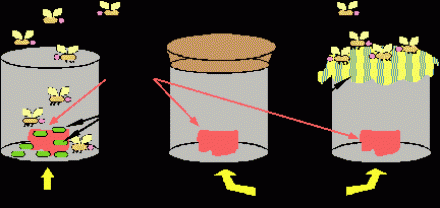All About Viruses and Bacteria
Spontaneous Generation Theory

Louis Pasteur
All the way through roman times all the way up to the 19th centaury the theory of spontaneous generation was the cause of most illnesses. People thought that living things like maggots could just appear out of non living things like meat. Because people couldn't see small microorganisms causing the disease or sickness, they assumed that it just appeared in certain things. At the time it seemed like a very logical idea. People thought mice were created by putting sweaty underwear with a husk of wheat into an opened mouthed jar. They believed that the sweat from the under where got into the wheat and changed it into a mouse. Now that may sound crazy, but back then it was what they saw. If they left the wheat out over night, they would awaken to it being gone and a mouse being there instead. If they did not see the mouse come in and eat the wheat they cloud assume that it came from the wheat. Spontaneous generation was a highly believed theory. It fit well with cultural and religious beliefs. It took a long time to disprove this theory. The first to challenge it was by Francesco Redi in 1668. He was an Italian physician and poet. Back then people thought maggots were generated form rotting meat. Francesco Redi did not believe this so he put the idea to the test. He first tested with meat in sealed jars and open jars. After a few days, the meat in the open jar had maggots and the meat in the closed jar did not. He suspected that the maggots were caused by flies that landed and laid their eggs in the meat. He then preformed another test. In this one the again set the meat out in open air, but this time he wrapped the meat in a cloth and kept it in open air. After a few days the meat from the open air had got onto the meat, but not the one wrapped in cloth because the flies could not get to it. Even with proof that spontaneous generation may not be the right answers; no won would change their ideas about spontaneous generation. The invention of the microscope only advanced the theory. Even though people could now see the microorganisms, they still appeared to come from nothing. People continued to debate over the theory. John Needham in 1775 preformed an experiment to try to test this theory to. At the time it was proven that if you boil a liquid, the microorganisms in it will die. John Needham boiled some chicken broth and then sealed it into a flask. He waited several days and then checked to see if there were any microorganisms. Since the container was sealed, no microorganisms should have grown, but when he checked there were. How did that happen? Well may not have boiled it long enough and bacteria could have got into the broth when he transferred it from the pot to the flask. An Italian priest, Lazzaro Spallanzani, tested this again, but he did not expose it to air after he boiled. Sure enough, he found that no microorganisms had grown, thus proving that John Needham was wrong. This though did not disprove spontaneous generation; he just showed that it could not happen with out air. The theory was not disproven until the young scientist Louis Pasteur proved it wrong in a contest for the best experiment proving or disproving spontaneous generation. He created an experiment that was a mix between the two last experiments. He boiled two flasks of meat, and then he took one and bent it into the shape of an S. The S one he left open, the other he left closed altogether. If it was true that microorganisms in the air caused the meat to spoil, then they would not spoil the meat in the S flask. They organisms would fall onto the middle curve on the S and not onto the meat. After a short time, the meat in the sealed container and the meat in the S flask both had not spoiled. This right here was the last straw for spontaneous generation. Louis Pasteur proved that spontaneous generation is false and also showed that microorganisms are everywhere, even in the air.

